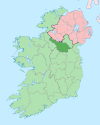- Moneensauran
-
Moneensauran is a townland in the Parish of Glangevlin, Barony of Tullyhaw, County Cavan, Ireland. The townland name is an anglicisation of the Gaelic placename “Móinín Samhradhán” which means ‘Samhradhán’s Little Bog’, which indicates that the owner Samhradhán lived nearby. Samhradhán, who lived about 1100 A.D., was Lord of Tullyhaw and the son of Conchobhar mac Fearghal and is the progenitor of the McGovern (name). All people with the surname McGovern derive from him, as their name means “Mág Samhradháin” or ‘Son of Samhradhán’. The townland name, along with the nearby townlands of Dunmakeever & Aghatirourke, offer important evidence that the McGovern clan originally came from Glangevlin and only later spread out to other parts of Tullyhaw such as Ballymagauran and Blacklion. The earliest surviving mention of the townland name is ‘Moneenshawran’ from a list of Co. Cavan townlands printed in 1790. Moneensauran is bounded on the north by Tullynacross and Curraghglass townlands, on the east by Derrynananta Upper & Derrynananta Lower townlands, on the south by Doon townland and on the west by Slievenakilla and Legatraghta townlands. Its chief geographical features are Benbrack Mountain reaching to an altitude of 1,600 feet above sea-level, the Owenmore River, Munter Eolus Lough and several waterfalls.
Moneensauran is traversed by some minor lanes.
The townland covers an area of 1,740 statute acres and is the third largest in County Cavan. In the 19th century the townland was owned by the Earls of Annesley. Griffith's Valuation of 1857 lists forty-two occupiers in the townland.[1] In the 1901 census of Ireland, there are twenty-three families listed in the townland.[2] In the 1911 census of Ireland, there are eighteen families listed in the townland.[3]
The historic sites in the townland are (1) A prehistoric cairn called ‘Cloghnacommerky’ situate on the border of Moneensauran and Doon townlands, (Site number 145, page 26, in “Archaeological Inventory of County Cavan”, Patrick O’Donovan, 1995) (2) Three medieval ringforts (Site numbers 993, 994 & 995, page 126 in “Archaeological Inventory of County Cavan”, Patrick O’Donovan, 1995) (3) A Sweathouse called the ‘duck house’, (Site number 1884, page 243, in “Archaeological Inventory of County Cavan”, Patrick O’Donovan, 1995). (4) Several gravel pits.
The Magauran family of Moneensauran was the predominant family in the parish. They produced many Roman Catholic priests through the centuries, including Dr. James Magauran who was bishop of Ardagh from 1815 to 1829. His brother Peter and sister Elizabeth Magauran were elected as the last King and Queen of Glan in 1815.
References
External links
Places in County Cavan County town: Cavan Towns Villages Agharaskilly • Aghavoher • Arvagh • Ballinagh (Bellananagh) • Ballyconnell • Ballyhaise • Ballymagauran • Ballymagovern • Bawnboy • Berrymount • Blacklion • Butlersbridge • Canningstown • Cavanagh • Cloncollow • Crossdoney • Cullyleenan • Derryginny • Dowra • Kilcogy • Killashandra • Kilnacreeva • Kilnaleck • Lisnahederna • Milltown • Mountnugent • Mullagh • Mullaghduff • Rakeelan • Redhills • Stradone • SwanlinbarLandforms Black Pig's Dyke • Dún na Rí Forest Park • Glengevlin • Lough Gowna • Lough Oughter • Lough Ramor • Lough Sillan • Magh Slécht • Shannon Cave • Shannon Pot • Slieve Cuilcagh • Slieve RushenCategory:Geography of County Cavan Categories:- Townlands of County Cavan
- County Cavan geography stubs
Wikimedia Foundation. 2010.

